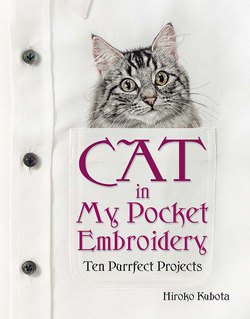Читать книгу Cat in My Pocket Embroidery - Hiroko Kubota - Страница 12
На сайте Литреса книга снята с продажи.
ОглавлениеWHAT YOU’LL NEED
In order to start painting with thread, you really need to have all your equipment ready to go. You will need needles for each thread color, pin cushions to hold them, your fabric and hoop, and a few other essentials. Luckily, embroidery equipment is not expensive, and if you buy good-quality products, they will not only make your work easier but will also last longer.
(1) FABRIC
Your number-one consideration when choosing a fabric is that it must be able to hold the embroidery in place. Plain-weave, nonstretch, fairly smooth fabrics—that are not too thick—such as linen and cotton, are ideal for both embroidery and tailoring. Oxford cotton and denim are good choices.
You can apply embroidery to cotton jersey (T-shirt fabric), but the area to be worked will need backing with a stabilizer, such as an iron-on interlining.
Avoid textured, coarsely woven, or thick fabrics, since these are challenging to embroider delicately, regardless of their thickness. Remember also that you need to be able to transfer detailed sketches to your fabric, so avoid fluffy woolens.
(2) INTERLINING
Lightweight or delicate fabrics will need strengthening in the embroidery area. An iron-on interlining is easily applied to the wrong side of the fabric following the manufacturer’s instructions. You then work the embroidery through both layers.
(3) NEEDLES
I always use size 10 embroidery needles. These support the single strands of size 25 embroidery floss that I use, but also fit my hand and make working comfortable. Feel free to experiment with thinner or thicker needles to find the right fit for you.
A slightly thicker needle may be necessary when working with a stiff fabric, and it can also be useful to use a needle one size bigger than your working needle to loosen holes as you work. If you find your stitches are always tight, try using a needle in the next size up.
(4) EMBROIDERY HOOP
A 6- or 7-inch (15- or 18-cm) embroidery hoop is the perfect size for the projects in this book. While a smaller hoop will hold the embroidery area, you really need space around the edges of the design to make working easier and more comfortable.
It is a good idea to diagonally bind the inner ring with cotton tape to provide a better grip to keep the fabric in place. Some hoops are lined with nonslip rubber, which can degrade and stain your fabric, so I suggest you remove old rubber and bind with cotton tape instead.
(5) TRANSFER PAPER
Dressmaker’s transfer paper leaves lines on the fabric that disappear on washing. Simply lay the transfer paper on top of your fabric and your template on top of that, then use a ballpoint pen to trace over the template lines.
(6) THREAD TRIMMERS
Small, sharp scissors are fine for cutting threads, but thread trimmers are especially good for cutting away the loose threads at the back of your embroidery.
(7) SEAM RIPPER
If you need to take stitches out, a seam ripper allows you to work under the stitch without cutting into the fabric below.
(8) PIN CUSHIONS
My thread-painting practice has been changed dramatically thanks to a cheap pin cushion found in a children’s sewing set. The sections all around the edge of the cushion really help me to organize my needles and threads.
You will be using a lot of similar thread colors to embroider your cats, so I advise you to organize your pin cushions well: having too many needles on a pin cushion will cause the threads to tangle, so you may well need more than one.
Group your shades in a way that is logical to you, then make ink dots on the cushions so you know where to replace your needle. You will also be able to pick up the shade of thread you need next more easily.
(9) THREADS
Separate skeins of size 25 embroidery floss and use single strands (see pages 18–19). The projects list exactly which thread shades to use, but keeping a more extensive selection at hand can be good for freestyle work and for feeding your creativity at the time of working—just like a painter who may have more colors on their palette than they actually use on the canvas.
